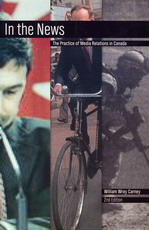
| Home News Releases | Calendar Contact |
Sources Bookshelf

In The News
The Practice of Media Relations in Canada
Carney, William Wray
Publisher: University of Alberta, Edmonton, CanadaYear Published: 2002
Pages: 225pp ISBN: 0-8864-382-9
Library of Congress Number: HD59.C37 2001 Dewey: 659.2
Please see our media profile in Sources:
Sources Select Resources
Do you have a message to convey but panic at the thoughts of having to talk to the media? Never fear. Former journalist William Carney has written a much-needed guide that will help you overcome your fear and master the art of media relations.
In the News, The Practice of Media Relations in Canada gives everyone, from student to seasoned practitioner, a thorough understanding of who the media are, how they work and how to approach them with stories. If ever you needed a lesson or a reminder of how to be media savvy - this is it.
The first step, if you haven't realized it already, is to acknowledge media relations as "one of the mainstays of the communications business." Carney's introduction emphasizes that "more opportunities exist than ever before for being 'in the news' and using news media as a means to communicate your issues to the public at large or to very targeted groups."
Then he proceeds to give us an easy-to-read, comprehensive instruction manual on how best to capitalize on these opportunities.
Carney's book, by his own definition, "is research-based and provides both a practical and a philosophical guide to dealing with media and reporters". It doesn't read like a text book. It reads like a precise, how-to guide for people intent on adopting a media-friendly communications style that is ethical, proactive and gets results.
Carney acknowledges that sometimes media relations involve more than providing factual information to a reporter. When a more "thoughtful, strategic and planned approach" is required, Carney provides the means by which to formulate and mobilize a communications business plan, including the situation analysis, research, policies and procedures, media training and evaluation.
Then Carney takes the "mystery" out of what drives the news. He gives clear instruction on how to find and write a good lead for a media release, how to make the best use of media conferences and attention-grabbing media stunts, while shedding light on many do-it-yourself techniques like letters to the editor, advertorials and community cable programming.
He continues the lesson by revealing the attributes of a good interview, how to conduct one and how to prepare for basic question and answer sessions.
The book comes to a close with a chapter on "The Fine Art of Complaining About the Media". After all, the media are people too and prone to making mistakes. How to correct those mistakes is Carney's final lesson.
I highly recommend this book for anyone involved in communications. Mastering the art and science of media relations is a powerful tool in your communications arsenal. The why and when of your talking to the media may as yet be uncertain. At least Carney is here to tell you how.
[Review by Lynn Fenske]
Subject Headings
- Accessibility
- Advertising
- Advocacy Groups
- Audience Research
- Blogs/Blogging
- Broadcasting
- Canadian Broadcasting Corporation (CBC)
- Canadian Media
- Communication
- Communications
- Communications/Crisis Management
- Communications Planning & Research
- Editors
- Government
- Internet/Media
- Interview Skills
- Interviewing
- Journalism
- Media Bias
- Media Ethics
- Media Industry/Business Issues
- Media Interviews
- Media Planning
- Media Relations
- Media Relations Tools
- Media Relations Training
- Message Communications
- News
- News Coverage
- News Media/Newsmedia
- Newsmakers
- Newspapers
- Newspapers/Community
- Non-Profit Organizations
- Political Affairs
- Political Personalities
- Politics
- Politics & Media
- Private Sector Training
- Public Interest
- Public Relations
- Radio
- Sources
- Television
- Website Development
- Writing
- Writing
© Sources 2023. The information provided is copyright and may not be reproduced in any form or by any means (whether electronic, mechanical or photographic), or stored in an electronic retrieval system, without written permission of the publisher.